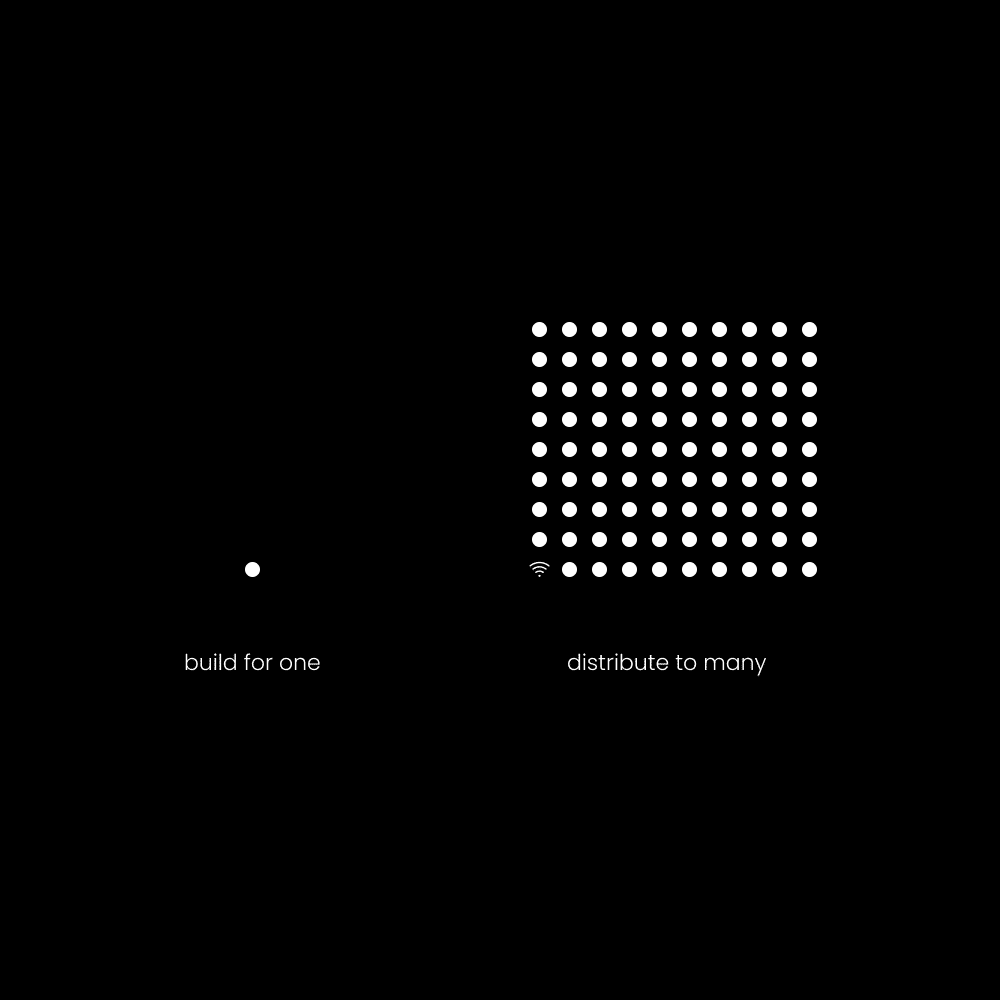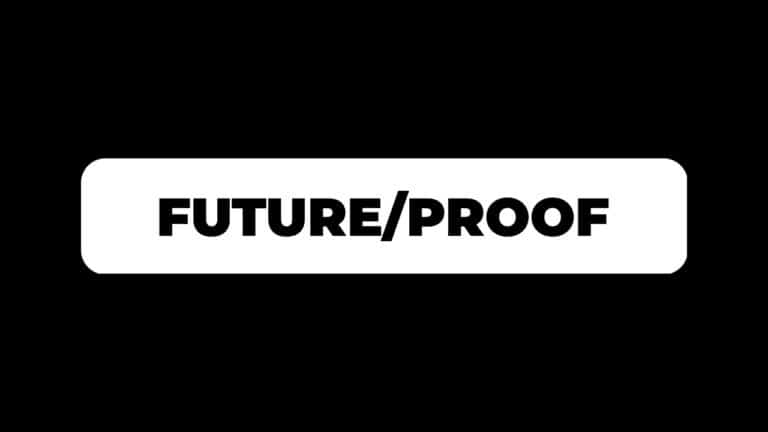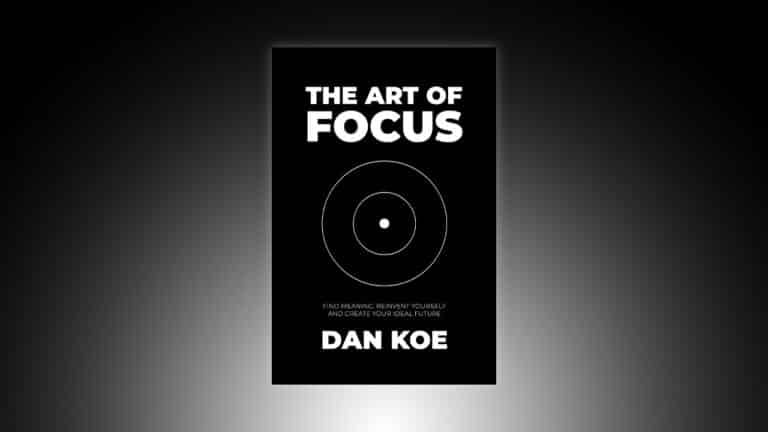I’m building a software company.
But I’m taking a different approach.
The common route would be to build the product, test it, and market it to a specific audience.
This works, but I want to skip the “sink or swim” phase of this business.
I am well aware that churn, developer costs, and engraining software in people’s daily lives will be difficult.
Instead, I plan to take the company to $5-$10 million in its first year.
(February 2, 2024 edit: we are well on track for this)
A lofty goal, yes.
But how?
By leveraging the experience I’ve gained in modern business.
I know the power of a personal brand. I know the power of digital products (and how a $10M digital product business is more profitable than most $50M physical product businesses). I know that I can use both to create an education product as the main driver of revenue in our first year of business – with that product operating at 95% profit margins.
We will build the company’s social media like we would a personal brand – with an “avatar” as the face of the brand. Most businesses have no idea what it takes to build an actual social media audience, so they rely on creator sponsorships. We want to create a creator.
We will use that audience, and a plethora of creator audiences, to fuel a cohort-based course around the subject of our software.
At that point, it doesn’t matter if the software itself is profitable in the first year. We can play long-term and slowly inject it into the creator economy as the one true second-brain software.
But, this letter isn’t about the software.
It’s about how you can start a hyper-profitable education business with the knowledge in your head.
You don’t need to build software to make this work.
Of course, you can build software based around the profitable education product you sell to enhance your business results (if you want to down the road – because you’ll have the money to invest in one).
Here’s what to expect:
- Why a social media audience is the highest leverage business asset.
- How to create your own customers (rather than trying to “find” them with boring market research).
- Realizing that you have $100,000 stuck in your head (and how to extract it).
If you want the full philosophy for the future of work, pick up The Art of Focus book on Amazon.
Audience Building Is The Greatest Skill Of The Decade
Personal brands are the new wave that won’t die out.
It’s not a phase, mom.
The digital world is expanding faster than the physical, and personal brands are the avatars that occupy the space.
Everyone has a personal brand. Everyone is in the creator economy. But few realize that their contributions (posts and products) aren’t contributions at all.
Consumers are too busy posting about their lives to impress friends who aren’t really friends.
Creators are learning, building, and distilling valuable information that makes life better for everyone.
The Realization Of Owned Distribution

I’m connected with and follow many high-level entrepreneurs.
Some in private equity, some in agency work, and some in software or related fields.
In almost every single conversation we have, the point of owned distribution comes up.
“I don’t know why I didn’t start posting content sooner.”
“It’s insane how much the marketing world has changed in a few short years, a personal brand is becoming less and less optional.”
Of course, this doesn’t eliminate the need for other types of distribution:
- Manual – like cold email, cold calls, or cold direct message campaigns.
- Bought – like purchasing Facebook or Google ads.
- Borrowed – like paying for podcast, YouTube, or newsletter sponsorships.
- Owned – like building an audience, newsletter, community, or list of product buyers.
The lines are blurred between them all, and I missed a few things like SEO, but they all have their use cases.
The first 3 are incredible for testing, beginner business owners, and having some form of control over your outcomes.
Owned distribution is a long-term game that scares most people away.
Let’s imagine I spent 2 years building a 100,000-person audience.
If I promoted my product every day for a month (in a smart way) I would get at least a million impressions.
How long would it take me to direct message a million people? A long time.
How much money would it cost for me to reach that many people with ads? Around $7,000 a month (based on $7 as an average CPM).
Not to mention, owned distribution compounds.
You can get to 10-20k followers in a year, 50-100k in two years, and millions after 4-5 years. That is, if you know how to iterate on your best content… or even write content in the first place.
It only makes sense to systemize your audience growth with time and leverage other distribution methods to make your desired revenue.
Once you see the power of personality, owned distribution, and flexibility of a personal brand – there’s no going back.
Audience Building Is A Stack Of High-Value Skills
To become a good audience builder, you can’t just study “audience building.”
This is the case for most skills that get abnormal results.
It’s not as simple as looking up a video on “the best skills to learn in 2023,” because that’s what everyone else is doing. It’s a great way to commoditize yourself and be replaceable.
Audience building is a stack of today’s most profitable skills:
- Graphic design
- Content writing
- Copywriting
- Marketing & sales
- Human nature
- Psychology
- Self-awareness
- Networking
And it demands multidisciplinary study and expertise.
Audience building is a lifestyle.
It is the act of capturing, curating, connecting, creating, and distributing valuable information, resources, and products in a way that impacts positive behavior change.
If you don’t pursue a better life for yourself, you will fail.
A better life demands the habits of learning, building, and distributing.
Rapid Fire Tips To Start Learning, Building & Distributing
Here is exactly what you must do (without the fluff).
These must become habit.
That means a part of your everyday life.
If you can spend 8 hours building someone else’s dreams, you can spend 1 hour building your own.
If you don’t have 1 hour a day to invest in having 2 hours a day, and so on, you need to get your priorities straight.
Learning with intention:
Learn the principles of marketing, sales, writing, and social media. Binge-watch 30-50 hours of free content and paid courses. Build your personal brand along the way so you actually apply what you learn.
Study what interests you. Do not limit yourself. If you have the goal of building a better life for yourself, anything you learn will be from that lens. You are still “focusing on one thing.”
When you feel the excitement, or dopamine, that comes from discovering a novel idea, write it down. Refine that idea and post it to your profile.
Build for yourself:
Pursue your goals and document the process. By document, I mean to keep running notes, logs, successes, and failures somewhere safe, physical or digital.
From your journey, you gain a knowledge of 100. From that, you can create a path of 1. This is how you pass down a unique system that markets itself and gets better results than those looking to make a quick buck.
Along the way, post the advice, lessons, and authentic successes and failures you’ve experienced. This is called “building in public.” Don’t do it for others. Do it as a digital journal. It will pay off.
Distribute a purposeful product:
Most people don’t realize that products are authority catalysts. They think they are “selling out” by selling a product, but don’t realize that it adds perceived authority to their brand, and they gain more loyal followers.
Create a product that you need, or needed, in your life. Something that would have helped you achieve where you are now, or something that will help you achieve something faster. This can be clothes for style, courses for knowledge, journal for productivity, or anything in between.
Sell to yourself and you won’t have to worry about competition.
Customer Creation Through Education
I don’t agree with 99% of business gurus out there.
Most of the hyper-successful ones are old and out of touch. Most of the young ones never question what the old ones say and forge a new path.
It is common advice to “build a product for a starving market, then attract that market as your audience.”
Yes, obviously this works.
But it also comes with the downsides of:
- Hating your customer base and not feeling motivated to work.
- Not having autonomy over what you write and build.
- Not being able to pivot into whatever topic or interest you are curious about.
- Being forced into a specific identity, which spills over into the entirety of your life.
When you prioritize education in your brand through courses, content, cohorts, and coaching (all optional), you unlock the ability to create your own customers.
Humans Are Learning Machines
Why does a starving market desire what they desire?
Why are they willing to pull out their card and pay for something they perceive as valuable?
Why are you told to “niche down” so you can get specific on the problem you leverage in your marketing?
Because of social conditioning, learning, and education.
You target a specific person because they are educated to have that identity.
Their identity influences what they desire (because of who they surround themselves with and what they see as opportunity).
When you create identities through education, by leading people towards your vision through your narrative, people grow to desire the product that will help them reach that goal.
The Levels Of Awareness
There is a marketing concept called the “levels of awareness” that will change your life.
It is a simple copywriting framework popularized by Eugene Schwartz in his book Breakthrough Advertising.
It doesn’t only apply to marketing, but everything.
Evolution is about solving problems in the macrocosm. Personal growth is about solving problems in the microcosm. Business is about solving problems to bridge the gap between the two.
Business is your contribution to humanity.
It is how you fulfill your life’s purpose of raising your consciousness (or awareness) and letting that impact the world like a ripple in water.
There are 5 levels of awareness:
- Unaware – unaware of the problem.
- Problem aware – aware of the problem.
- Solution aware – aware of a solution(s) to the problem.
- Product aware – aware of your solution to the problem.
- Most aware – aware of the vast impact that problem is having on their quality of life.
Your job as an education brand is to hit all of these levels.
You must make your audience aware of the problems you’ve solved in your life (and how that problem impacts their life).
You must give advice, lessons, and tips to show that there is a solution.
You must market a product that solves the problem faster just by the nature of invested attention.
People don’t log on to social media to solve their problems. It isn’t a learning platform. And most people can’t focus, research, and figure out a path for themselves.
That is why products are valuable.
Because people know they are investing in a solution. Then, their attention and behavior follow suit.
Free education only works for the 1% that have been conditioned to be motivated and ambitious. Even they still see the value in aggregated information, and will probably buy out of convenience.
The Balance Of Long-Form & Short-Form
For the uninitiated, there are 2 main types of content (and communication).
- Long-form – podcasts, videos, articles, newsletters, conversations, movies, and sometimes long social posts like threads.
- Short-form – tweets, shorts, reels, texts, emails, big ideas, and your favorite quotes.
Each has its pros and cons, but long term, they are both necessary to build an audience that trusts you. Trust is the “new” sales hack that people are starting to catch onto.
Short-form is for capturing attention, building a large audience, and funneling that audience to deeper sources of value (long-form platforms, products, and services).
Long-form is for holding invested attention, segmenting your audience, and building trust through expertise.
The balance of both forces you to have value to deliver. If you don’t have a habit of self-education, building products or systems, and using writing as a way to clarify your thoughts and ideas – you are delaying the inevitable.
I am aware that most of my readers are beginners.
For you, I recommend starting with one long-form channel and one short-form.
Eventually, when you do this full-time and systemize your process you can repurpose those to all platforms.
For long-form, I recommend a newsletter. Why?
- You can practice when nobody is watching.
- You can build a database of content to repurpose into blogs, YouTube, and solo podcasts.
- Long-form builds depth and connection with your audience so you don’t have to rely on pushy sales tactics to make a living.
- You are forced to develop original ideas that spill over into your short-form content.
For short-form, I recommend a writing platform like X. Why?
- You don’t have to show your face or body (having a headshot as your profile picture helps of course).
- You learn to monetize your mind instead of your looks. Your income depends on your creativity.
- You can test multiple ideas each day and repurpose your best ones to other platforms like Instagram and LinkedIn to grow faster.
- You can use your writing as scripts for shorts, reels, and TikToks.
I teach this entire process in 2 Hour Writer.
Start with 30 minutes of writing each morning.
Write a long-form newsletter. Use the ideas you write about as short posts. Eventually, let your engagement data act as a compass for what you write more about.
You Have $100,000 Trapped In Your Head
I wrote an entire letter about how to package up the knowledge in your head to create a $100,000 product. Give it a read if you don’t want to stop after this letter.
First, let’s handle the prime objection of information products in general:
“It’s not real.”
“It’s not tangible.”
“It’s just words on a screen.”
If the root of your existence (and quality of life) is your mind, and your mind is an information processing machine, and the information you consume heavily influences where you end up in life (and the people’s lives you impact) – information products are the greatest product one can sell.
Anyone who tells you otherwise has not thought it through or experienced the business model. They are conditioned by their favorite guru’s worldview and can’t escape it.
I am moving toward the belief that every single business should have a foundation of education.
Every single business should have an information product to distribute positive behavior change at scale.
Not to mention, the fact that they have 95%+ profit margins is a sign that the economy will continue to favor the education market. Technology and evolution have led us to this point, and who are you to question Mother Nature?
How To Eliminate All Saturation
Build a product for your past self or current self.
One that accelerates the progress made toward a meaningful goal.
Your marketing will revolve around the Universal principle of human behavior:
- Purpose – a compelling reason to move toward a better future.
- Path – a process, system, or steps that bring clarity to their actions.
- Priority – the burning problem they face at their level of awareness.
If you like productivity, create a workflow with education around that.
If you like spirituality, create meditations with education around that.
If you like fitness, create a program with education around that.
You can’t improve what doesn’t exist, so don’t stress the first iteration. This is a long game of improvement.
“But what about my customer avatar and market research?”
It’s you.
You are the niche.
You are the customer avatar.
Write the content and promotions that would speak to you.
There are a lot of moving pieces to this. It will take a year or so to actually feel like you are getting the hang of it.
But don’t make the mistake and thinking that this is a unique case. Every single thing you’ve done in life has been a process of trial and error.
Just because you are older and have psychological barriers built up doesn’t mean you can’t build a business like you learned to walk.
I hope you enjoyed this one, my friends.
Have a great weekend.
– Dan Koe



